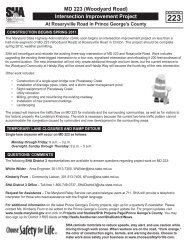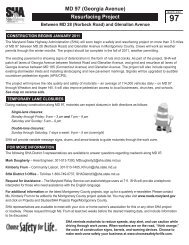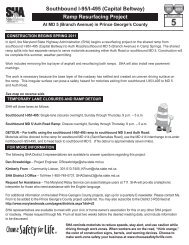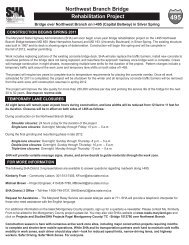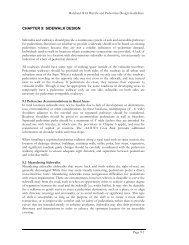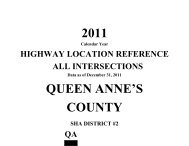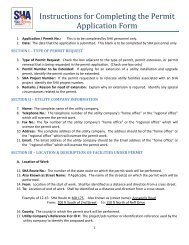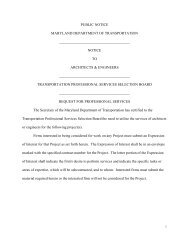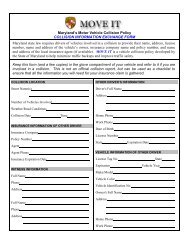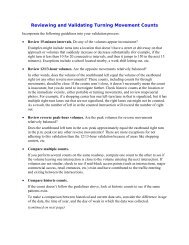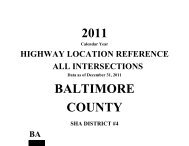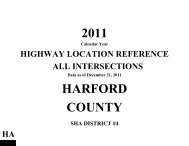Pipes - Maryland State Highway Administration
Pipes - Maryland State Highway Administration
Pipes - Maryland State Highway Administration
You also want an ePaper? Increase the reach of your titles
YUMPU automatically turns print PDFs into web optimized ePapers that Google loves.
3.5 PIPES AND PIPE ARCHES<br />
Historical Overview<br />
It is not known when pipes came into use as small structures on <strong>Maryland</strong>’s roadways.<br />
In the first report of the <strong>Maryland</strong> Geological Survey in 1899, there are several<br />
references to pipes as well as illustrations of the construction methods for pipe culverts<br />
(Johnson 1899: 273, 275). (See Figure 3.16.) For example, it was reported in Kent<br />
County that:<br />
Much attention has . . . been paid to building substantial culverts in all<br />
parts of the County. They are made of tile drains [pipes] with ends well<br />
protected by neat brick walls carried two or three feet above the level of<br />
the roadway (Johnson 1899: 240).<br />
The report states that stone was also used to protect the ends of tile pipe cross drains.<br />
The next report of the Geological Survey contains a reference to a 30-inch pipe (built<br />
because of a failed effort to construct a concrete box culvert) but the composition of the<br />
pipe is not stated (Reid 1902: 133). Subsequent reports include references to both terra<br />
cotta and iron pipes (Johnson 1906: 286). The 1905-06 report stated that “either iron or<br />
vitrified clay pipes may be used for culverts up to 24 inches in diameter, the ends being<br />
in all cases protected by stone masonry. The larger culverts may be built of concrete”<br />
(Crosby 1906: 375). That same report discussed replacing the dangerous wooden<br />
structures with pipe culverts or concrete bridges (Crosby 1906: 379). The next year, the<br />
state’s Chief <strong>Highway</strong> Engineer advocated rebuilding the existing roadways and<br />
replacing small bridges with pipes (Crosby 1908: 71).<br />
Figure 3.16. End elevation and longitudinal section of a pipe culvert under an<br />
embankment (Johnson 1899: 273, Fig. 8).<br />
Pipe culverts are mentioned in the <strong>State</strong> Roads Commission’s Report of 1916. The<br />
1932 Report contains at least two references to replacing wooden bridges with<br />
corrugated metal pipe (<strong>Maryland</strong> <strong>State</strong> Roads Commission 1934: 72). The types of<br />
3-31
pipes listed in the Materials Section of the report include: cast iron, reinforced concrete<br />
pipe, vitrified pipe and tile, and corrugated metal pipe (<strong>Maryland</strong> <strong>State</strong> Roads<br />
Commission 1934: 53). In the 1937-38 Report, it was noted that 6,276 feet of<br />
corrugated metal pipe culvert ranging in size from 12 inches in diameter to 60 inches<br />
was laid in order to “provide for better drainage” (<strong>Maryland</strong> <strong>State</strong> Roads Commission<br />
1939: 124).<br />
<strong>Pipes</strong> are ubiquitous and have continued in use through this century up to the present<br />
for either drainage under roadways or to conduct small waterways under the roadway.<br />
The use of the iron and tile pipes of the early part of this century has been superseded<br />
by concrete and corrugated metal pipes. Pipe arches came into use after World War II.<br />
Description<br />
As small structures on <strong>Maryland</strong>’s roadways, pipes are generally cross drainage<br />
structures situated well below the roadway surface. These are often referred to as pipe<br />
culverts. Earthen fill is placed to the sides of the pipe and between the pipe and the<br />
roadway. The pipe is generally a round structure but can be elliptical or arched. As<br />
stated above, pipe culverts can be of cast iron, tile, corrugated metal or concrete.<br />
In metal pipes, the pipe is generally made of a single plate, formed and welded. A<br />
variation of this is the pipe arch that generally consists of an arched section of pipe.<br />
Figures 3.17, 3.18 and 3.19 are illustrations of types of pipes. Some examples of pipes<br />
and pipe arches on <strong>Maryland</strong>’s roadways are:<br />
10048XO MD 550 over Branch of Hunting Creek, Frederick County 1930<br />
3-foot x 2-foot cast iron pipe, concrete headwall, 2-foot fill between top of pipe<br />
and roadway, 24-foot wide roadway.<br />
18044XO MD 245 over Cockold Creek, St. Mary’s County 1936<br />
15-foot wide corrugated pipe arch, concrete foundation, headwalls and<br />
wingwalls, 5-foot fill between top of structure and roadway, 22-foot wide roadway<br />
02048XO MD 270 over Branch of Furnace Creek, Anne Arundel County ND<br />
8-foot x 6-foot elliptical corrugated metal pipe, concrete headwall, 10 feet of fill<br />
between top of structure and roadway.<br />
21178XO MD 67 over Tributary of Israel Creek, Washington County 1970<br />
6-foot structural plate pipe, concrete headwall and wingwalls, 21-foot wide<br />
roadway.<br />
08048XO MD 227 over Ponmonkey Mill Swamp, Charles County ND<br />
3.1-foot corrugated metal pipe, no wingwalls or headwalls, 2-foot fill between top<br />
of structure and roadway, 26-foot wide roadway.<br />
Tips for Dating <strong>Pipes</strong><br />
Wrought iron is no longer used for pipes; most iron pipes would pre-date World War I.<br />
Concrete has been used throughout this century and would be very difficult to date.<br />
Extant corrugated metal pipes are known to date to the 1930s as are corrugated metal<br />
3-32
pipe arches. Pipe arches date generally from the 1930s to the present; many of these<br />
are associated with modern Interstate construction.<br />
Figure 3.17. Concrete pipe shapes (Source: FHWA 1991:19-4).<br />
3-33
Figure 3.18. Standard corrugated steel culvert shapes (Source: FHWA 1991: 19-5).<br />
3-34
Figure 3.19. Details, standard metal or concrete pipe (Source: <strong>Maryland</strong> <strong>State</strong><br />
<strong>Highway</strong> <strong>Administration</strong> 1986: MD-360.01).<br />
3-35



